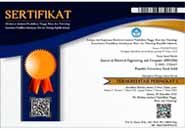Blind Safety Belt to Detect Obstacles Using Ultrasonic Sensors and GPS
Authors (s)
(1) * Muhammad Alamsyah
 (Universitas Muhammadiyah Sidoarjo)
(Universitas Muhammadiyah Sidoarjo) Indonesia
(2) Izza Anshory (Universitas Muhammadiyah Sidoarjo)
Indonesia
(3) Akhmad Ahfas (Universitas Muhammadiyah Sidoarjo)
Indonesia
(4) Dwi Hadidjaja Rasjid (Universitas Muhammadiyah Sidoarjo)
Indonesia
(*) Corresponding Author
AbstractIn modern times, everything has rapidly developed, including public facilities provided by the government for the comfort of everyone. One of them is facilities for visually impaired individuals. In terms of language, guiding blocks are blocks used as directional markers. These facilities are built as an effort by the government to enable visually impaired individuals to walk independently. However, these facilities are often misused by others who disregard the needs of visually impaired individuals. As a result, the facilities get damaged, and the visually impaired individuals are the ones affected. Therefore, researchers have created an innovative tool to assist visually impaired individuals in their daily activities, which is easy to use. "Safety Belt to Detect Obstacles Using Ultrasonic Sensors and GPS" is a device capable of detecting obstacles or objects in front and producing a sound when the object is in close proximity to the user. It has a minimalist design and is equipped with a GPS module to help determine the user's location. This device utilizes ultrasonic sensors implemented on Arduino and is equipped with a buzzer that can sound an alert when the distance between the user and an object is close. We hope that the creation of this device can improve the quality of life for its users.
|
Keywords
elektro; elektronica; control
Full Text: PDF
Refbacks
- There are currently no refbacks.
Copyright (c) 2023 Muhammad Alamsyah

This work is licensed under a Creative Commons Attribution License (CC BY-SA 4.0)
Journal of Electrical Engineering and Computer (JEECOM)
Published by LP3M Nurul Jadid University, Indonesia, Probolinggo, East Java, Indonesia.








